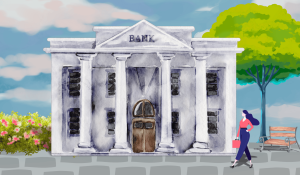
What are “CDFIs” and what is community investing?
Community development financial institutions (or CDFIs), are banks, credit unions, and other financial-services organizations, such as community development loan funds, that measure their returns both in terms of financial profitability and social impact. They operate with the express goal of creating resources and opportunities for groups, businesses, and individuals who are under-served by traditional financial institutions. When you choose to place your banking or investment dollars with CDFIs to help further these goals, you are participating in community investing.
Community investors help finance projects that lift communities economically. In rural and urban areas (and internationally), community investors provide capital that supports job creation, financial services to low-income individuals, start-up funds for small businesses, loans for affordable housing, and more.
In other words, community investing helps you to maximize the social change created by your banking and investment dollars. (Read stories of community investing successes here, and here, and here.)
 |
|
Community investing has grown significantly over the last 15 years. As of 2010, CDFIs held assets of $41.7 billion, more than ten times their holdings in 1995. The rapid growth seen starting in 2007 has been attributed in part to consumer dissatisfaction with conventional banks as the US recession unfolded.*
|
How safe are community investments?
All personal holdings in banks and credit unions (including community investment banks and credit unions) are insured up to $250,000 per financial institution by the federal government. You don’t have to worry about losing any money up to that cap. Shifting your checking or savings accounts to a community development bank or credit union should be a largely seamless shift that can make a real difference in how you use your money to support your social and environmental goals. (Read our profile of one Green American who “broke up with her bank” here.)
Community development loan funds — like conventional loan funds — are not insured by the FDIC. Still, of the 508 community development financial institutions surveyed through the CDFI Data Project through 2007 (the latest date for which data is available), none have reported that they have ever lost any investor principal.
How have community investing banks fared during the global economic crisis?
The recession has certainly taken its toll on all sectors of the economy, but in the banking world, those most harmed by the housing collapse were those involved in predatory, abusive, and profiteering lending practices — sourcing toxic assets like sub-prime loans, for example. These practices, which caused so much turmoil for the economy, sit squarely at odds with the standard operating practice of community development banks and credit unions.
According to the FDIC, in 2009 a total of 140 US banks failed, up from 28 in 2008, and the highest overall total since 1992. Of these, the National Community Investment Fund (NCIF) reports that only one was a community development bank. Exact numbers for 2010 were not available at the time of this guide’s publication, though published estimates from the FDIC and NCIF indicate a year similar to 2009.
Meanwhile, the National Federation of Community Development Credit Unions reports that deposits in its sector have actually outpaced the growth of conventional credit unions during the recession. Its 2009 financial trends report found that community development credit unions (CDCUs) experienced significant increases in membership, deposits, and size of their loan portfolios in 2009.What’s more, the American Recovery and Reinvestment Act of February 2009 appropriated an extra $100 million to CDFIs certified as such by the government, enhancing their lending capacities.
In testimony before the House Financial Services Committee, CDFI Fund director Donna Gambrell said, “The new economic environment has offered very real opportunities for CDFIs to expand their impact in the communities they serve. ... We are uniquely positioned to serve low-income and economically distressed communities.”
And in a July 2010 article comparing CDFI performance with conventional banks’ performance during the recession, analyst Bob Adkins of Community Bank Ventures showed that while CDFIs’ return on assets (ROA) have lagged behind their conventional counterparts, they also continued strong growth throughout 2008, while the rest of the economy contracted. Explains Adkins: “There has been a pent-up need for products and services offered by CDFI banks in the communities they serve, as many of these communities have been under-served by traditional banks.” For more on the economic crisis and CDFIs, see this article.
Besides banking, what other community investing options are available?
Lots! Community development loan funds provide financing for cooperatives, green businesses, nonprofit organizations, and economic development projects. Microenterprise loan funds provide small loans to entrepreneurs in the US and overseas. Community development venture capital funds provide loans to businesses creating jobs for low-income communities, and some socially responsible mutual funds devote up to ten percent of their assets to community investing. You can even find credit cards through community development banks. Remember that it’s only accounts at community development banks and credit unions that are federally insured up to $250,000. Loan funds, venture capital funds, and other vehicles are not insured, so the risk is higher. As with all investment options, you or your financial adviser should investigate them thoroughly to ensure they meet your social and financial goals. (Find a clickable list of resources in the online PDF version of our Community Investing Guide, also available for purchase as a print magazine.)
Do I need large sums of money to invest in communities?
You do not need large sums of money to invest in communities. Many options have low or no minimum amounts.
What impact will community investing have on my investment returns?
If you choose to shift your checking or savings account to a CDFI, or dump your mega-bank credit card in favor of a CDFI-sponsored credit card, you should find that interest rates and other terms will be comparable to those at traditional banks and credit unions.
With community development loan funds and micro enterprise funds, the return on investment will usually run between zero and four percent. In a roaring market, your returns might be more modest than other investment vehicles. In a faltering market, when many stocks begin paying negative returns, returns on community investments may turn out comparatively better.
Either way, the social returns are greater with community investments, and no matter what type of market we’re in, experts agree that investors should diversify their portfolios to minimize risk. Community investing can be a healthy part of a diversified portfolio.
Why not just give the money to charity?
A potential $20 reduction in the return on a community investment vs. a conventional investment vastly exceeds the social-change capabilities of a $20 gift to charity.
What’s more, community investing can be much more empowering for low-income individuals looking to use their own skills and talents to lift themselves economically. Your money’s power to change a community ripples out from the initial borrower who then embarks on a venture that will provide education, jobs, clean energy, child care, or any number of other critical business and infrastructure needs for their local community.
Continue to be generous in giving to charity, and then also consider breaking up with your mega-bank, and moving at least one percent of your portfolio into community investing.
*Chart created by the Social Investment Forum Foundation for the 2010 Report on Socially Responsible Investing Trends in the United States, using data from the Aspen Institute, Calvert Foundation, CDFI Data Project, CDVCA, National Community Investment Fund, National Federation of Community Development Credit Unions, and Opportunity Finance Network.






